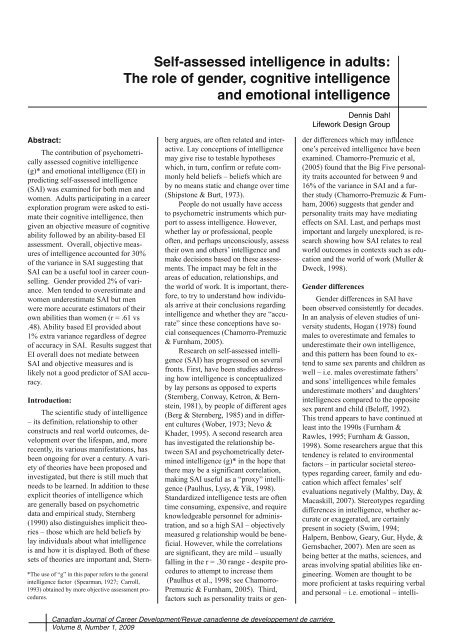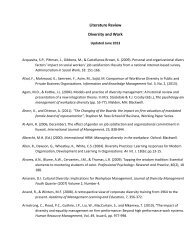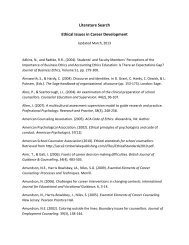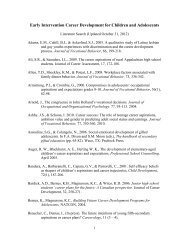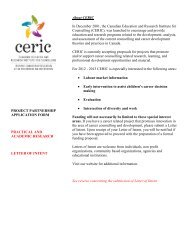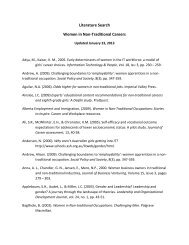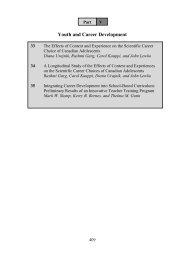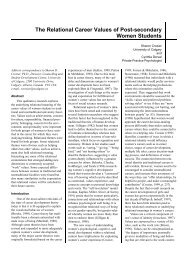Self-assessed intelligence in adults: The role of gender ... - ceric
Self-assessed intelligence in adults: The role of gender ... - ceric
Self-assessed intelligence in adults: The role of gender ... - ceric
You also want an ePaper? Increase the reach of your titles
YUMPU automatically turns print PDFs into web optimized ePapers that Google loves.
Abstract:<br />
<strong>The</strong> contribution <strong>of</strong> psychometrically<br />
<strong>assessed</strong> cognitive <strong><strong>in</strong>telligence</strong><br />
(g)* and emotional <strong><strong>in</strong>telligence</strong> (EI) <strong>in</strong><br />
predict<strong>in</strong>g self-<strong>assessed</strong> <strong><strong>in</strong>telligence</strong><br />
(SAI) was exam<strong>in</strong>ed for both men and<br />
women. Adults participat<strong>in</strong>g <strong>in</strong> a career<br />
exploration program were asked to estimate<br />
their cognitive <strong><strong>in</strong>telligence</strong>, then<br />
given an objective measure <strong>of</strong> cognitive<br />
ability followed by an ability-based EI<br />
assessment. Overall, objective measures<br />
<strong>of</strong> <strong><strong>in</strong>telligence</strong> accounted for 30%<br />
<strong>of</strong> the variance <strong>in</strong> SAI suggest<strong>in</strong>g that<br />
SAI can be a useful tool <strong>in</strong> career counsell<strong>in</strong>g.<br />
Gender provided 2% <strong>of</strong> variance.<br />
Men tended to overestimate and<br />
women underestimate SAI but men<br />
were more accurate estimators <strong>of</strong> their<br />
own abilities than women (r = .61 vs<br />
.48). Ability based EI provided about<br />
1% extra variance regardless <strong>of</strong> degree<br />
<strong>of</strong> accuracy <strong>in</strong> SAI. Results suggest that<br />
EI overall does not mediate between<br />
SAI and objective measures and is<br />
likely not a good predictor <strong>of</strong> SAI accuracy.<br />
Introduction:<br />
<strong>The</strong> scientific study <strong>of</strong> <strong><strong>in</strong>telligence</strong><br />
– its def<strong>in</strong>ition, relationship to other<br />
constructs and real world outcomes, development<br />
over the lifespan, and, more<br />
recently, its various manifestations, has<br />
been ongo<strong>in</strong>g for over a century. A variety<br />
<strong>of</strong> theories have been proposed and<br />
<strong>in</strong>vestigated, but there is still much that<br />
needs to be learned. In addition to these<br />
explicit theories <strong>of</strong> <strong><strong>in</strong>telligence</strong> which<br />
are generally based on psychometric<br />
data and empirical study, Sternberg<br />
(1990) also dist<strong>in</strong>guishes implicit theories<br />
– those which are held beliefs by<br />
lay <strong>in</strong>dividuals about what <strong><strong>in</strong>telligence</strong><br />
is and how it is displayed. Both <strong>of</strong> these<br />
sets <strong>of</strong> theories are important and, Stern-<br />
*<strong>The</strong> use <strong>of</strong> “g” <strong>in</strong> this paper refers to the general<br />
<strong><strong>in</strong>telligence</strong> factor (Spearman, 1927; Carroll,<br />
1993) obta<strong>in</strong>ed by more objective assessment procedures.<br />
<strong>Self</strong>-<strong>assessed</strong> <strong><strong>in</strong>telligence</strong> <strong>in</strong> <strong>adults</strong>:<br />
<strong>The</strong> <strong>role</strong> <strong>of</strong> <strong>gender</strong>, cognitive <strong><strong>in</strong>telligence</strong><br />
and emotional <strong><strong>in</strong>telligence</strong><br />
berg argues, are <strong>of</strong>ten related and <strong>in</strong>teractive.<br />
Lay conceptions <strong>of</strong> <strong><strong>in</strong>telligence</strong><br />
may give rise to testable hypotheses<br />
which, <strong>in</strong> turn, confirm or refute commonly<br />
held beliefs – beliefs which are<br />
by no means static and change over time<br />
(Shipstone & Burt, 1973).<br />
People do not usually have access<br />
to psychometric <strong>in</strong>struments which purport<br />
to assess <strong><strong>in</strong>telligence</strong>. However,<br />
whether lay or pr<strong>of</strong>essional, people<br />
<strong>of</strong>ten, and perhaps unconsciously, assess<br />
their own and others’ <strong><strong>in</strong>telligence</strong> and<br />
make decisions based on these assessments.<br />
<strong>The</strong> impact may be felt <strong>in</strong> the<br />
areas <strong>of</strong> education, relationships, and<br />
the world <strong>of</strong> work. It is important, therefore,<br />
to try to understand how <strong>in</strong>dividuals<br />
arrive at their conclusions regard<strong>in</strong>g<br />
<strong><strong>in</strong>telligence</strong> and whether they are “accurate”<br />
s<strong>in</strong>ce these conceptions have social<br />
consequences (Chamorro-Premuzic<br />
& Furnham, 2005).<br />
Research on self-<strong>assessed</strong> <strong><strong>in</strong>telligence</strong><br />
(SAI) has progressed on several<br />
fronts. First, have been studies address<strong>in</strong>g<br />
how <strong><strong>in</strong>telligence</strong> is conceptualized<br />
by lay persons as opposed to experts<br />
(Sternberg, Conway, Ketron, & Bernste<strong>in</strong>,<br />
1981), by people <strong>of</strong> different ages<br />
(Berg & Sternberg, 1985) and <strong>in</strong> different<br />
cultures (Wober, 1973; Nevo &<br />
Khader, 1995). A second research area<br />
has <strong>in</strong>vestigated the relationship between<br />
SAI and psychometrically determ<strong>in</strong>ed<br />
<strong><strong>in</strong>telligence</strong> (g)* <strong>in</strong> the hope that<br />
there may be a significant correlation,<br />
mak<strong>in</strong>g SAI useful as a “proxy” <strong><strong>in</strong>telligence</strong><br />
(Paulhus, Lysy, & Yik, 1998).<br />
Standardized <strong><strong>in</strong>telligence</strong> tests are <strong>of</strong>ten<br />
time consum<strong>in</strong>g, expensive, and require<br />
knowledgeable personnel for adm<strong>in</strong>istration,<br />
and so a high SAI – objectively<br />
measured g relationship would be beneficial.<br />
However, while the correlations<br />
are significant, they are mild – usually<br />
fall<strong>in</strong>g <strong>in</strong> the r = .30 range - despite procedures<br />
to attempt to <strong>in</strong>crease them<br />
(Paulhus et al., 1998; see Chamorro-<br />
Premuzic & Furnham, 2005). Third,<br />
factors such as personality traits or gen-<br />
Canadian Journal <strong>of</strong> Career Development/Revue canadienne de developpement de carriére<br />
Volume 8, Number 1, 2009<br />
Dennis Dahl<br />
Lifework Design Group<br />
der differences which may <strong>in</strong>fluence<br />
one’s perceived <strong><strong>in</strong>telligence</strong> have been<br />
exam<strong>in</strong>ed. Chamorro-Premuzic et al,<br />
(2005) found that the Big Five personality<br />
traits accounted for between 9 and<br />
16% <strong>of</strong> the variance <strong>in</strong> SAI and a further<br />
study (Chamorro-Premuzic & Furnham,<br />
2006) suggests that <strong>gender</strong> and<br />
personality traits may have mediat<strong>in</strong>g<br />
effects on SAI. Last, and perhaps most<br />
important and largely unexplored, is research<br />
show<strong>in</strong>g how SAI relates to real<br />
world outcomes <strong>in</strong> contexts such as education<br />
and the world <strong>of</strong> work (Muller &<br />
Dweck, 1998).<br />
Gender differences<br />
Gender differences <strong>in</strong> SAI have<br />
been observed consistently for decades.<br />
In an analysis <strong>of</strong> eleven studies <strong>of</strong> university<br />
students, Hogan (1978) found<br />
males to overestimate and females to<br />
underestimate their own <strong><strong>in</strong>telligence</strong>,<br />
and this pattern has been found to extend<br />
to same sex parents and children as<br />
well – i.e. males overestimate fathers’<br />
and sons’ <strong><strong>in</strong>telligence</strong>s while females<br />
underestimate mothers’ and daughters’<br />
<strong><strong>in</strong>telligence</strong>s compared to the opposite<br />
sex parent and child (Bel<strong>of</strong>f, 1992).<br />
This trend appears to have cont<strong>in</strong>ued at<br />
least <strong>in</strong>to the 1990s (Furnham &<br />
Rawles, 1995; Furnham & Gasson,<br />
1998). Some researchers argue that this<br />
tendency is related to environmental<br />
factors – <strong>in</strong> particular societal stereotypes<br />
regard<strong>in</strong>g career, family and education<br />
which affect females’ self<br />
evaluations negatively (Maltby, Day, &<br />
Macaskill, 2007). Stereotypes regard<strong>in</strong>g<br />
differences <strong>in</strong> <strong><strong>in</strong>telligence</strong>, whether accurate<br />
or exaggerated, are certa<strong>in</strong>ly<br />
present <strong>in</strong> society (Swim, 1994;<br />
Halpern, Benbow, Geary, Gur, Hyde, &<br />
Gernsbacher, 2007). Men are seen as<br />
be<strong>in</strong>g better at the maths, sciences, and<br />
areas <strong>in</strong>volv<strong>in</strong>g spatial abilities like eng<strong>in</strong>eer<strong>in</strong>g.<br />
Women are thought to be<br />
more pr<strong>of</strong>icient at tasks requir<strong>in</strong>g verbal<br />
and personal – i.e. emotional – <strong>in</strong>telli-
gences. Likely, it is the <strong>in</strong>teraction <strong>of</strong> biological<br />
and environmental factors that<br />
sways one’s perception <strong>of</strong> <strong><strong>in</strong>telligence</strong>.<br />
Emotional <strong><strong>in</strong>telligence</strong><br />
<strong>The</strong> concept <strong>of</strong> emotional <strong><strong>in</strong>telligence</strong><br />
(EI) has been present <strong>in</strong> the literature<br />
for many decades (Thorndike,<br />
1920; Wechsler, 1950) but has become<br />
much more popular as a research topic<br />
s<strong>in</strong>ce Goleman’s (1995) book Emotional<br />
Intelligence propelled the idea <strong>in</strong>to public<br />
consciousness. It has been embraced<br />
enthusiastically by many people as evidence<br />
that cognitive <strong><strong>in</strong>telligence</strong> is not<br />
the only <strong><strong>in</strong>telligence</strong> needed to be successful,<br />
and may, <strong>in</strong> fact, be secondary.<br />
So far, this evidence has not been forthcom<strong>in</strong>g<br />
to the extent orig<strong>in</strong>ally claimed.<br />
Various theories and accompany<strong>in</strong>g<br />
measur<strong>in</strong>g <strong>in</strong>struments (<strong>in</strong> brackets)<br />
have been developed, primary among<br />
them be<strong>in</strong>g Bar-On’s Emotional-Social<br />
Intelligence model (Emotional Quotient<br />
Inventory - EQi); Goleman’s Emotional<br />
Competencies model (Emotional Competencies<br />
Inventory - ECI); and Mayer,<br />
Salovey, and Caruso’s ability-based<br />
model (Mayer-Salovey-Caruso Emotional<br />
Intelligence Test – MSCEIT). EI<br />
theories have been criticized for their<br />
lack <strong>of</strong> consistency <strong>of</strong> def<strong>in</strong>ition as well<br />
as lack <strong>of</strong> discrim<strong>in</strong>ant validity from<br />
other constructs (Roberts, Zeidner, &<br />
Matthews, 2001). In particular, EI assessment<br />
<strong>in</strong>struments that rely on selfjudgment<br />
have been found to correlate<br />
too greatly with scales <strong>of</strong> personality<br />
and lack psychometric support (Conte,<br />
2005). Research <strong>in</strong> EI is expand<strong>in</strong>g <strong>in</strong><br />
an attempt to validate the construct by<br />
show<strong>in</strong>g that it is related to real-world<br />
social, work, and personal outcomes.<br />
To date very little research exists<br />
which explores the relationship between<br />
one’s realistic perception <strong>of</strong> abilities and<br />
emotional <strong><strong>in</strong>telligence</strong>. It would be reasonable<br />
to expect that those who know<br />
themselves well, and are therefore accurate<br />
<strong>in</strong> their self-appraisals, would score<br />
more highly on measures <strong>of</strong> EI. <strong>The</strong><br />
current study seeks to add to the SAI literature<br />
by <strong>in</strong>vestigat<strong>in</strong>g the relationship<br />
<strong>of</strong> SAI to the relatively new construct <strong>of</strong><br />
emotional <strong><strong>in</strong>telligence</strong>, <strong>in</strong> particular,<br />
whether accuracy <strong>of</strong> self-assessment is<br />
positively related to higher emotional<br />
<strong><strong>in</strong>telligence</strong>. Gender differences have<br />
been found with both SAI and EI,<br />
(Furnham & Rawles, 1995; Brackett,<br />
Rivers, Shiffman, Lerner,& Salovey,<br />
2006) and it was therefore decided that<br />
analyses for both sexes were appropriate.<br />
<strong>Self</strong>-evaluation studies have been<br />
criticized on various issues and would<br />
benefit from meet<strong>in</strong>g at least two m<strong>in</strong>imum<br />
standards (Colv<strong>in</strong>, Block, & Funder,<br />
1995). First, any evaluation <strong>of</strong> a<br />
person’s self-appraisal accuracy must<br />
<strong>in</strong>clude a valid criterion for comparison.<br />
Second, it would be more useful to exam<strong>in</strong>e<br />
participants more representative<br />
<strong>of</strong> the general population. One concern<br />
with social science research <strong>in</strong> general<br />
is that, because <strong>of</strong> ease <strong>of</strong> access, the<br />
preponderance <strong>of</strong> samples are taken<br />
from a university student population and<br />
such has been the case for much <strong>of</strong> the<br />
SAI literature reviewed. This practice is<br />
problematic <strong>in</strong> that students, while<br />
be<strong>in</strong>g <strong>adults</strong>, do not represent society as<br />
a whole <strong>in</strong> variables such as age, general<br />
<strong><strong>in</strong>telligence</strong> level, education level,<br />
as well as life stage with respect to career.<br />
It was felt that research with adult,<br />
non-student men and women may shed<br />
a different light on how SAI, <strong>gender</strong>,<br />
and EI behave.<br />
Traditionally, the ability to perceive<br />
one’s self realistically has been considered<br />
an <strong>in</strong>dicator <strong>of</strong> mental health (Vogt<br />
& Colv<strong>in</strong>, 2005). While some researchers<br />
have argued that self-deception<br />
may contribute to psychological<br />
well-be<strong>in</strong>g (Taylor & Brown, 1988;<br />
Colv<strong>in</strong> & Block, 1994), the majority <strong>of</strong><br />
the literature appears to suggest the opposite.<br />
Kruger and Dunn<strong>in</strong>g (1999)<br />
argue that <strong>in</strong>dividuals who are <strong>in</strong>competent<br />
<strong>in</strong> certa<strong>in</strong> doma<strong>in</strong>s <strong>of</strong>ten lack<br />
awareness <strong>of</strong> “…how well one is perform<strong>in</strong>g,<br />
when one is likely to be accurate<br />
<strong>in</strong> judgment, and when one is likely<br />
to be <strong>in</strong> error” (p. 1121).<br />
That <strong>in</strong>dividuals do <strong>of</strong>ten consciously<br />
or unconsciously misrepresent<br />
their abilities is well documented and<br />
this tendency is a major drawback to the<br />
credibility <strong>of</strong> self-report assessment <strong>in</strong>struments<br />
<strong>in</strong> all areas <strong>of</strong> client evaluation<br />
and research (Paulhaus, 1991;<br />
Paulhaus, Harms, Bruce, & Lysy, 2003).<br />
<strong>Self</strong>-report <strong>in</strong>ventories, therefore, are<br />
suspect s<strong>in</strong>ce it <strong>of</strong>ten is the case that<br />
those who rate themselves most erroneously<br />
compared with an objective<br />
measure are the most <strong>in</strong>competent <strong>in</strong><br />
perform<strong>in</strong>g the task (Kruger and Dun-<br />
<strong>Self</strong>-<strong>assessed</strong> Intelligence <strong>in</strong> Adults<br />
33<br />
n<strong>in</strong>g, 1999). As a result, <strong>in</strong> order to<br />
avoid compound<strong>in</strong>g self-assessment<br />
error, <strong>in</strong> this study it was decided that an<br />
ability-based EI <strong>in</strong>strument – the MS-<br />
CEIT - would be the most effective way<br />
to measure EI. Current reviews <strong>of</strong> EI <strong>in</strong>struments<br />
tend to confirm this choice<br />
(Conte, 2005; McEnrue & Groves,<br />
2006).<br />
Frijda (1988) argues that “emotions...arise<br />
<strong>in</strong> response to events that<br />
are important to the <strong>in</strong>dividual, and<br />
which importance he or she appraises <strong>in</strong><br />
some way” (p. 349). Further, emotions<br />
systems, when activated, have been<br />
found to <strong>in</strong>fluence cognitive processes<br />
such as attention, learn<strong>in</strong>g and memory<br />
lead<strong>in</strong>g to adaptive behaviours (Muramatsu<br />
and Hanoch, 2005). Mayer, Salovey<br />
and Caruso contend that emotions<br />
convey mean<strong>in</strong>gs about relationships <strong>of</strong><br />
a person with self, others, objects, or<br />
events – <strong>in</strong> other words, matters which<br />
are personal and rise out <strong>of</strong> one’s concerns,<br />
motives or goals (Mayer, Salovey,<br />
& Caruso, 2004; Frijda, 1988).<br />
When these relationships change, emotions<br />
are triggered. EI, <strong>in</strong> their view, <strong>in</strong>volves<br />
the ability to recognize emotions,<br />
identify and th<strong>in</strong>k about them, and use<br />
them to problem-solve so as to adapt to<br />
the environment. It is around this theory<br />
that the MSCEIT has been developed.<br />
With<strong>in</strong> this context, one would expect<br />
the process <strong>of</strong> self-evaluation to be an<br />
emotionally-laden experience. Presumably<br />
the act <strong>of</strong> <strong>in</strong>trospection, especially<br />
<strong>in</strong> the area <strong>of</strong> cognitive abilities which<br />
are seen as be<strong>in</strong>g very important to success<br />
<strong>in</strong> western society, would trigger<br />
many emotions. In this study, it is hypothesized<br />
that the extent to which <strong>in</strong>dividuals<br />
recognize and use these<br />
emotions to manage themselves and<br />
their environments should be reflected<br />
<strong>in</strong> the accuracy <strong>of</strong> SAI. In other words,<br />
EI should contribute to the variance <strong>in</strong><br />
SAI above and beyond that <strong>of</strong> cognitive<br />
g.<br />
Questions<br />
In particular, the questions <strong>of</strong> <strong>in</strong>terest<br />
were these:<br />
1) What is the contribution <strong>of</strong> <strong>gender</strong><br />
to SAI variance above and beyond<br />
that <strong>of</strong> g?<br />
2) Are there <strong>gender</strong> differences <strong>in</strong> SAI<br />
accuracy <strong>in</strong> an adult non-student<br />
sample?<br />
Canadian Journal <strong>of</strong> Career Development/Revue canadienne de developpement de carriére<br />
Volume 8, Number 1, 2009
<strong>Self</strong>-<strong>assessed</strong> Intelligence <strong>in</strong> Adults<br />
34<br />
3) In this sample, do men overestimate<br />
and women underestimate SAI as<br />
previously found?<br />
4) What is the contribution <strong>of</strong> EI, if<br />
any, to SAI and do some aspects <strong>of</strong><br />
EI contribute more than others?<br />
5) Are there <strong>gender</strong> differences <strong>in</strong> the<br />
<strong>role</strong> <strong>of</strong> EI <strong>in</strong> SAI?<br />
Method:<br />
Participants:<br />
Participants were 350 <strong>adults</strong> attend<strong>in</strong>g<br />
a 4-week government funded career<br />
exploration program. All were unemployed<br />
at the time <strong>of</strong> the research. Age<br />
ranged from 18 to 63 years with an average<br />
age <strong>of</strong> 36.4 years (s.d. = 11.5),<br />
40% were male. <strong>The</strong> average grade<br />
level achieved was 12.6 (s.d. = 2.2).<br />
Instruments:<br />
Wonderlic Personnel Test (WPT):<br />
<strong>The</strong> Wonderlic Personnel Test is a shortform<br />
test <strong>of</strong> cognitive ability (g) purported<br />
to measure “the level at which an<br />
<strong>in</strong>dividual learns, understands <strong>in</strong>structions<br />
and solves problems” (Wonderlic,<br />
1992). Its sizeable reliability and validity<br />
estimates are based on an adult<br />
work<strong>in</strong>g population. Test-retest reliabilities<br />
are reported rang<strong>in</strong>g from .82 to .94,<br />
and concurrent validities <strong>of</strong> >.80 with<br />
the WAIS-R and about .80 with the<br />
GATB-G have been observed (Wonderlic,<br />
1992). <strong>The</strong> WPT manual reports<br />
mean raw score and standard deviation<br />
values <strong>of</strong> 21.6 and 7.1 respectively compared<br />
with 24.8 and 6.7 obta<strong>in</strong>ed <strong>in</strong> the<br />
current <strong>in</strong>vestigation.<br />
<strong>The</strong> manual makes provision for<br />
two scores – a timed (12 m<strong>in</strong>ute) score,<br />
and an untimed score which is considered<br />
the more representative <strong>of</strong> an <strong>in</strong>dividual’s<br />
true ability if he or she obta<strong>in</strong>s<br />
a requisite additional number <strong>of</strong> questions<br />
correct when no time restrictions<br />
are imposed.<br />
<strong>The</strong> Career Oriented Multiple Intelligence<br />
Test (COMIT):<br />
<strong>The</strong> COMIT is a self-report <strong>in</strong>strument<br />
(unpublished) <strong>in</strong> which persons<br />
are asked to rate their abilities <strong>in</strong> eight<br />
different doma<strong>in</strong>s patterned after the <strong><strong>in</strong>telligence</strong>s<br />
proposed by Howard Gardner<br />
(Gardner, 1983, 1998). Individuals<br />
respond to 64 statements (eight per doma<strong>in</strong>),<br />
by rat<strong>in</strong>g their abilities on a five-<br />
po<strong>in</strong>t scale (1 = not at all like me, to 5 =<br />
def<strong>in</strong>itely me!). Statements are <strong>in</strong>direct<br />
– that is, they <strong>in</strong>quire about <strong>in</strong>terests,<br />
behaviours, and everyday situations<br />
rather than ask<strong>in</strong>g about <strong><strong>in</strong>telligence</strong> directly.<br />
Examples <strong>of</strong> items <strong>in</strong>clude: “I<br />
can easily compute numbers <strong>in</strong> my<br />
head” (mathematical/logical doma<strong>in</strong>), or<br />
“I can express my thoughts well on<br />
paper” (l<strong>in</strong>guistic doma<strong>in</strong>). <strong>The</strong> mean<br />
<strong>in</strong>ternal consistency (Cronbach’s alpha)<br />
<strong>of</strong> the COMIT’s eight <strong><strong>in</strong>telligence</strong>s is<br />
>.80.<br />
Us<strong>in</strong>g strategies outl<strong>in</strong>ed <strong>in</strong> Paulhaus<br />
et al., (1998), responses on 22 <strong>of</strong><br />
the 64 items are weighted and used to<br />
derive a self-<strong>assessed</strong> <strong><strong>in</strong>telligence</strong> (SAI)<br />
score which is a client’s perceived estimate<br />
<strong>of</strong> cognitive ability. Correlations <strong>of</strong><br />
the COMIT SAI score currently stand at<br />
a moderate .55 with the WPT and at .53<br />
with the GATB-G (General Learn<strong>in</strong>g<br />
Aptitude) score (n = 640), which are<br />
very reasonable for proxy IQ estimates<br />
and higher than the approximate r = .30<br />
that is normally reported <strong>in</strong> the literature<br />
(Chamorro-Premuzic & Furnham,<br />
2005). Cronbach’s alpha for the 22<br />
items is .86.<br />
Mayer-Salovey-Caruso Emotional Intelligence<br />
Test (MSCEIT):<br />
<strong>The</strong> MSCEIT has been designed to<br />
assess an <strong>in</strong>dividual’s emotional <strong><strong>in</strong>telligence</strong><br />
us<strong>in</strong>g an objective or abilitybased<br />
method <strong>in</strong> which test-takers are<br />
required to perform eight different types<br />
<strong>of</strong> tasks <strong>in</strong> the emotion doma<strong>in</strong>. <strong>The</strong><br />
total MSCEIT score is subdivided <strong>in</strong>to<br />
two ma<strong>in</strong> area scores – Experiential EI<br />
and Strategic EI. Experiential EI is purported<br />
to measure more basic-level<br />
emotional processes such as “the identification<br />
<strong>of</strong> emotion and its productive<br />
use <strong>in</strong> thought” (Caruso & Wolfe,<br />
2006). This area is further divided <strong>in</strong>to<br />
two branches –Perceiv<strong>in</strong>g Emotions and<br />
Facilitat<strong>in</strong>g Thought. Strategic EI is assumed<br />
to <strong>in</strong>volve higher-level emotions<br />
process<strong>in</strong>g such as reason<strong>in</strong>g about<br />
emotions, manag<strong>in</strong>g emotions, and<br />
us<strong>in</strong>g this <strong>in</strong>formation <strong>in</strong> personal and<br />
social decision-mak<strong>in</strong>g (Caruso &<br />
Wolfe, 2006). It is also comprised <strong>of</strong><br />
two branches – Understand<strong>in</strong>g Emotions<br />
and Manag<strong>in</strong>g Emotions. Raw<br />
scores on the MSCEIT are converted to<br />
standard scores hav<strong>in</strong>g a mean <strong>of</strong> 100<br />
and a standard deviation <strong>of</strong> 15.<br />
Canadian Journal <strong>of</strong> Career Development/Revue canadienne de developpement de carriére<br />
Volume 8, Number 1, 2009<br />
Reliability <strong>of</strong> the MSCEIT is good<br />
at the total, area and branch levels with<br />
total scores hav<strong>in</strong>g a split-half reliability<br />
<strong>of</strong> .91 and area score reliabilities <strong>of</strong> .90<br />
for Experiential EI and .85 for Strategic<br />
EI. Test-retest reliability has been found<br />
to be .86. McEnrue and Groves (2006)<br />
described the MSCEIT as hav<strong>in</strong>g high<br />
construct validity, moderate content,<br />
predictive and external validity and low<br />
face validity.<br />
Procedure:<br />
In a career-counsellor led brief discussion,<br />
small groups <strong>of</strong> participants<br />
were asked to share their views regard<strong>in</strong>g<br />
the nature and possible k<strong>in</strong>ds <strong>of</strong> <strong><strong>in</strong>telligence</strong>,<br />
after which they were<br />
adm<strong>in</strong>istered the SAI measure<br />
(COMIT), followed immediately by the<br />
WPT. All clients were allowed as much<br />
time as needed after the <strong>in</strong>itial 12<br />
m<strong>in</strong>ute adm<strong>in</strong>istration <strong>of</strong> the WPT, and<br />
the more representative score (timed or<br />
untimed) was then used for data analysis.<br />
<strong>The</strong> MSCEIT was computer adm<strong>in</strong>istered<br />
several days later.<br />
Data Analysis:<br />
WPT raw scores were first adjusted<br />
to one form (A) to correct for slight differences<br />
between the A and B forms <strong>of</strong><br />
the test. Pearson-product correlations<br />
between overall SAI, MSCEIT total,<br />
area, and branch scores, and WPT<br />
scores were conducted and are shown <strong>in</strong><br />
Table 1. Similar analyses were also performed<br />
separately for men and women<br />
(Table 2). T-tests were conducted to determ<strong>in</strong>e<br />
significant differences between<br />
sexes (Table 3). Outliers greater than 2.0<br />
sd (10 cases) were excluded from the<br />
analysis.<br />
Follow<strong>in</strong>g the procedures <strong>of</strong><br />
Chamorro-Premuzic and Furnham<br />
(2006) a regression analysis was performed<br />
us<strong>in</strong>g SAI as the criterion and<br />
psychometrically measured g, EI branch<br />
scores, and <strong>gender</strong> as predictors. Results<br />
are shown <strong>in</strong> Table 4.<br />
To determ<strong>in</strong>e the extent to which<br />
men and women over- or underestimate<br />
SAI, raw scores for WPT and SAI were<br />
converted to standardized z-scores and<br />
the differences between WPT and SAI<br />
z-scores calculated (z-WPT m<strong>in</strong>us z-<br />
SAI).
Results:<br />
Tables 1 through 4 are shown <strong>in</strong> the Appendix.<br />
See Table 1 for the descriptive statistics<br />
and <strong>in</strong>tercorrelations for all measures<br />
used. Overall correlation <strong>of</strong> SAI<br />
with g is r = .55.<br />
Men were found to slightly overestimate<br />
SAI (mean z = -.07) and women<br />
to underestimate SAI (mean z = .06).<br />
<strong>The</strong>se differences were not significant.<br />
Overall, accuracy <strong>of</strong> SAI did show a<br />
positive and significant correlation with<br />
the total EI score <strong>of</strong> the MSCEIT, but<br />
this relationship fell to near 0 when g<br />
was partialed out.<br />
Discussion:<br />
<strong>The</strong> purpose <strong>of</strong> this study was to<br />
explore a) whether <strong>gender</strong> differences<br />
are observed <strong>in</strong> SAI <strong>in</strong> an adult non-student<br />
sample as has previously been the<br />
case; and b) whether emotional <strong><strong>in</strong>telligence</strong><br />
plays a <strong>role</strong> <strong>in</strong> an <strong>in</strong>dividual’s<br />
ability to assess him/herself above and<br />
beyond that contributed by psychometrically<br />
measured g and <strong>gender</strong>.<br />
<strong>The</strong> overall contribution <strong>of</strong> <strong>gender</strong><br />
to SAI (Question 1), even though significant,<br />
was negligible at about 2%, less<br />
than what has been reported elsewhere.<br />
As seen <strong>in</strong> Table 2, males <strong>in</strong> this study<br />
were considerably more accurate <strong>in</strong> predict<strong>in</strong>g<br />
their <strong><strong>in</strong>telligence</strong> (r = .61 for<br />
males vs. r=.48 for females)(Question<br />
2). <strong>The</strong> reason for this is not clear but it<br />
appears they generally had a realistic<br />
self-view – at least <strong>in</strong> this area. Overall,<br />
males did overestimate their <strong><strong>in</strong>telligence</strong>s<br />
and females did underestimate<br />
theirs, but the differences were not significant<br />
(Question 3). It is possible that<br />
engag<strong>in</strong>g <strong>in</strong> the process <strong>of</strong> career decision-mak<strong>in</strong>g<br />
had more <strong>of</strong> a sober<strong>in</strong>g effect<br />
on the male <strong>adults</strong> <strong>in</strong> this sample<br />
than the females. In addition, as discussed<br />
earlier, lay perceptions <strong>of</strong> <strong><strong>in</strong>telligence</strong><br />
change over time. Perhaps earlier<br />
stereotypes <strong>of</strong> male <strong>in</strong>tellectual superiority,<br />
more overt <strong>in</strong> past generations,<br />
have moderated <strong>in</strong> the past decade as<br />
people become more egalitarian <strong>in</strong> their<br />
attitudes. This hypothesis needs to be<br />
<strong>in</strong>vestigated more thoroughly.<br />
<strong>The</strong> correlations <strong>of</strong> SAI with g were<br />
found to be higher than has been previously<br />
reported; the overall r <strong>of</strong> .55 exceeds<br />
the usual r <strong>of</strong> approximately .30<br />
by a considerable amount <strong>in</strong>dicat<strong>in</strong>g that<br />
the participants <strong>in</strong> this study had more<br />
<strong>in</strong>sight – at least <strong>in</strong>to their own cognitive<br />
abilities. <strong>The</strong>re may be several reasons<br />
for this. First, the <strong>in</strong>dividuals <strong>in</strong> the<br />
study were <strong>adults</strong> seek<strong>in</strong>g career direction<br />
on their own volition and may have<br />
been more focused on their abilities <strong>in</strong><br />
preparation for career exploration. Perhaps<br />
this m<strong>in</strong>d set encouraged more accurate<br />
self-evaluation. In addition,<br />
participants were prepared for the SAI<br />
by a brief discussion regard<strong>in</strong>g <strong><strong>in</strong>telligence</strong>.<br />
This, too, may have activated<br />
schemata around the topic, thereby <strong>in</strong>creas<strong>in</strong>g<br />
metacognition and enhanc<strong>in</strong>g<br />
self-evaluation accuracy. Third, it could<br />
also be that the SAI <strong>in</strong>strument used, <strong>in</strong><br />
some way capitalized on those aspects<br />
<strong>of</strong> g that allowed the participants to<br />
judge themselves more precisely. In any<br />
event, the measured g accounted for<br />
about 30% <strong>of</strong> the variance <strong>of</strong> SAI.<br />
Correlations <strong>of</strong> this magnitude<br />
make SAI a useful tool <strong>in</strong> the portfolio<br />
<strong>of</strong> assessments necessary for a comprehensive<br />
evaluation <strong>in</strong> such areas as career<br />
counsell<strong>in</strong>g. Individuals engaged <strong>in</strong><br />
career exploration are likely to take one<br />
<strong>of</strong> two paths upon completion – go directly<br />
<strong>in</strong>to the work environment, or<br />
enter tra<strong>in</strong><strong>in</strong>g and education programs<br />
lead<strong>in</strong>g to a chosen vocation. In either<br />
case, know<strong>in</strong>g how <strong>in</strong>dividuals view<br />
their abilities compared with a standardized<br />
measure provides a good start<strong>in</strong>g<br />
po<strong>in</strong>t for career counsell<strong>in</strong>g <strong>in</strong> <strong>in</strong>vestigat<strong>in</strong>g<br />
why discrepancies between SAI<br />
and g, if any, are occurr<strong>in</strong>g. Such a discussion<br />
could be important for all participants<br />
<strong>in</strong> this process. In particular, it<br />
may be most beneficial for those persons<br />
with low SAI and high g who view<br />
their abilities pessimistically. Subjective<br />
beliefs <strong>of</strong>ten become self-fulfill<strong>in</strong>g<br />
prophecies, and chang<strong>in</strong>g the belief may<br />
have a positive effect on future endeavors.<br />
For those who are accurate and realistic<br />
about their abilities, this<br />
knowledge confirms what they already<br />
know which can be reassur<strong>in</strong>g. <strong>The</strong> effect<br />
on high SAI/low g <strong>in</strong>dividuals<br />
could be mixed; some may benefit by<br />
readjust<strong>in</strong>g their goals, thus possibly<br />
sav<strong>in</strong>g time and f<strong>in</strong>ancial resources,<br />
while others may either ignore the <strong>in</strong>formation<br />
or be negatively affected by it.<br />
Large SAI/ g differences can also be<br />
used as a rationale to further <strong>in</strong>vestigate<br />
an <strong>in</strong>dividual’s abilities, s<strong>in</strong>ce there may<br />
<strong>Self</strong>-<strong>assessed</strong> Intelligence <strong>in</strong> Adults<br />
35<br />
be other factors such as learn<strong>in</strong>g disabilities,<br />
attention problems, or physical or<br />
mental illnesses <strong>in</strong>terfer<strong>in</strong>g with cognition.<br />
Contrary to what was expected, EI<br />
did not appear to play any <strong>role</strong> <strong>in</strong> people’s<br />
perceptions <strong>of</strong> ability (Question 4),<br />
overall or for either <strong>gender</strong> (Question<br />
5). This was observed at total, area, and<br />
branch levels <strong>of</strong> the MSCEIT . While<br />
correlations with SAI were significant<br />
for the Understand<strong>in</strong>g and Manag<strong>in</strong>g<br />
branches (Table 1), this relationship<br />
dropped to almost 0 when the effect <strong>of</strong><br />
cognitive g was partialed out. This suggests<br />
that the MSCEIT may be provid<strong>in</strong>g<br />
<strong>in</strong>formation regard<strong>in</strong>g a person’s<br />
accumulated knowledge and experience<br />
regard<strong>in</strong>g emotional function<strong>in</strong>g, analogous<br />
to Cattell’s (1971) theory <strong>of</strong> crystallized<br />
<strong><strong>in</strong>telligence</strong>. Mayer et al. (2000)<br />
argue that the Understand<strong>in</strong>g branch <strong>of</strong><br />
the MSCEIT model is the most cognitive<br />
<strong>of</strong> the branches, and should therefore<br />
be related more to cognitive g as it<br />
is seen to do <strong>in</strong> this analysis.<br />
<strong>Self</strong>-evaluation, particularly as it<br />
perta<strong>in</strong>s to the world <strong>of</strong> career and further<br />
education, would seem an emotionally<br />
charged phenomenon. Ability tends<br />
to limit careers that can be pursued, and<br />
such barriers have potential for generat<strong>in</strong>g<br />
emotional stress. <strong>Self</strong>-assessment <strong>in</strong><br />
any area br<strong>in</strong>gs to the fore discrepancies<br />
that may exist between what is and what<br />
is desired. It seems reasonable to suppose<br />
that <strong>in</strong>dividuals who are able to<br />
perceive this environment more accurately<br />
and adapt to it by emotional problem<br />
solv<strong>in</strong>g would display higher<br />
emotional <strong><strong>in</strong>telligence</strong>. This was not<br />
seen to be the case. However, before<br />
draw<strong>in</strong>g any conclusions, it is necessary<br />
to look at the contexts with<strong>in</strong> which EI<br />
may have been demonstrated, and the<br />
aspects <strong>of</strong> EI required <strong>in</strong> each <strong>of</strong> these.<br />
<strong>The</strong> MSCEIT asks the <strong>in</strong>dividual to<br />
solve various emotional “problems”, but<br />
does not – and cannot at this juncture –<br />
evaluate the “feel<strong>in</strong>gs” or somatic experience<br />
that occurs <strong>in</strong> any k<strong>in</strong>d <strong>of</strong> emotion-laden<br />
event. Know<strong>in</strong>g “about” an<br />
emotional problem and how to theoretically<br />
solve it from a distance, as it were,<br />
and “feel<strong>in</strong>g” the emotions generated <strong>in</strong><br />
actual situations are quite different and<br />
have potentially different behavioural<br />
consequences. Despite be<strong>in</strong>g the most<br />
<strong>in</strong>vestigated and validated EI <strong>in</strong>strument<br />
Canadian Journal <strong>of</strong> Career Development/Revue canadienne de developpement de carriére<br />
Volume 8, Number 1, 2009
<strong>Self</strong>-<strong>assessed</strong> Intelligence <strong>in</strong> Adults<br />
36<br />
so far <strong>in</strong> the nascent world <strong>of</strong> EI measurement,<br />
the MSCEIT is limited, as any<br />
paper and pencil (or computerized) test<br />
is, <strong>in</strong> what aspects <strong>of</strong> EI it can measure.<br />
It appears that <strong>in</strong> this study, whatever<br />
component is be<strong>in</strong>g measured by<br />
the MSCEIT does not appear to be play<strong>in</strong>g<br />
a part <strong>in</strong> self-evaluation. This <strong>in</strong> no<br />
way denigrates the <strong>in</strong>strument, but it<br />
does emphasize the fact that those who<br />
are develop<strong>in</strong>g EI measurement tools<br />
have a very difficult task <strong>in</strong> separat<strong>in</strong>g<br />
the various components <strong>of</strong> what is still a<br />
poorly def<strong>in</strong>ed construct.<br />
Suggestions for further research:<br />
SAI needs to be <strong>in</strong>vestigated across<br />
the lifespan to determ<strong>in</strong>e whether accuracy<br />
changes with age and <strong>gender</strong>. Prelim<strong>in</strong>ary<br />
analysis <strong>of</strong> the data <strong>in</strong> this<br />
study suggests that young males are<br />
wildly <strong>in</strong>accurate <strong>in</strong> their self-assessments<br />
while older males are very accurate.<br />
Females appear much more<br />
moderate at every age level. This has<br />
implications for career counsellors, especially<br />
those deal<strong>in</strong>g with young career-explor<strong>in</strong>g<br />
men, <strong>in</strong> that the results <strong>of</strong><br />
any other self-reported assessments<br />
should perhaps be viewed with more<br />
caution.<br />
Replication studies similar to those<br />
reported <strong>in</strong> Chamorro-Premuzic &<br />
Furnham (2005 – chapter 6), should be<br />
carried out to determ<strong>in</strong>e whether past<br />
trends regard<strong>in</strong>g male SAI overestimation<br />
and female underestimation are<br />
chang<strong>in</strong>g and why.<br />
If the MSCEIT is found to measure<br />
more <strong>of</strong> a crystallized aspect <strong>of</strong> emotional<br />
<strong><strong>in</strong>telligence</strong>, this implies that<br />
there may also be a fluid component<br />
(see Ortony, Revelle & Z<strong>in</strong>barg, 2007).<br />
Investigat<strong>in</strong>g this possibility and attempt<strong>in</strong>g<br />
to measure it are still issues<br />
that need to be resolved.<br />
More formalized procedures need<br />
to be developed around us<strong>in</strong>g SAI to<br />
augment and question standardized test<br />
scores. Longitud<strong>in</strong>al studies that follow<br />
<strong>in</strong>dividuals <strong>in</strong>to career sett<strong>in</strong>gs would<br />
provide valuable <strong>in</strong>formation regard<strong>in</strong>g<br />
which are the more accurate predictors<br />
<strong>of</strong> success.<br />
Appendix<br />
Table 1: Descriptive statistics <strong>in</strong>clud<strong>in</strong>g overall means, standard deviations<br />
and <strong>in</strong>ter-correlations for all measures.<br />
mean sd 2 3 4 5 6 7 8 9<br />
1 WPT (g) 24.8 6.7 .55** .33** .20** .17** .16** .35** .44** .16**<br />
2 SAI 25.2 5.7 - .21** .09 .09 .07 .27** .29** .17**<br />
3 Total EI 93.5 11.9 - .89** .75** .75** .77** .67** .62**<br />
4 Exper. EI 98.3 13.7 - .87** .78** .43** .38** .36**<br />
5 Perceiv<strong>in</strong>g 98.2 13.1 - .41** .31** .28** .24**<br />
6 Facilitat<strong>in</strong>g 97.8 14.0 - .48** .39** .44**<br />
7 Strat. EI 91.5 10.0 - .86** .79**<br />
8 Underst. 92.8 11.4 - .39**<br />
9 Manag<strong>in</strong>g 93.3 9.0 -<br />
*p
Table 4: Regression analysis: psychometric <strong><strong>in</strong>telligence</strong> (g), EI branch<br />
scores, and <strong>gender</strong> as predictors <strong>of</strong> SAI<br />
variables<br />
entered % <strong>of</strong> variance expla<strong>in</strong>ed<br />
step R 2<br />
R 2<br />
df F t<br />
#1 g<br />
.55 11.74**<br />
.300 .300 1,321 137.76<br />
#2<br />
#3<br />
g<br />
perceiv<strong>in</strong>g<br />
facilitat<strong>in</strong>g<br />
understand<strong>in</strong>g<br />
manag<strong>in</strong>g<br />
g<br />
perceiv<strong>in</strong>g<br />
facilitat<strong>in</strong>g<br />
understand<strong>in</strong>g<br />
manag<strong>in</strong>g<br />
<strong>gender</strong><br />
*p
<strong>Self</strong>-<strong>assessed</strong> Intelligence <strong>in</strong> Adults<br />
38<br />
Intelligence Test (MSCEIT): User’s<br />
manual. Toronto, ON: Multi-Health<br />
Systems.<br />
Mayer, J., Salovey, P., & Caruso, D.<br />
(2004). Emotional <strong><strong>in</strong>telligence</strong>:<br />
<strong>The</strong>ory, f<strong>in</strong>d<strong>in</strong>gs and implications.<br />
Psychological Inquiry, 15(3), 197-<br />
215.<br />
McEnrue, & Groves, (2006). Choos<strong>in</strong>g<br />
among tests <strong>of</strong> emotional <strong><strong>in</strong>telligence</strong>:<br />
What is the evidence?<br />
Human Resource Development<br />
Quarterly, 17(1), 9-42.<br />
Muller, C. & Dweck, C. (1998). Praise<br />
for <strong><strong>in</strong>telligence</strong> can underm<strong>in</strong>e children’s<br />
motivation and performance.<br />
Journal <strong>of</strong> Personality and Social<br />
Psychology, 75, 33-42.<br />
Nevo, B. & Khader, A. (1995). Crosscultural,<br />
<strong>gender</strong> and age differences<br />
<strong>in</strong> S<strong>in</strong>gaporean mothers’ conceptions<br />
<strong>of</strong> children’s <strong><strong>in</strong>telligence</strong>.<br />
Journal <strong>of</strong> Social Psychology, 135,<br />
509-517.<br />
Ortony, A., Revelle, W., & Z<strong>in</strong>barg, R.<br />
(2007). Why emotional <strong><strong>in</strong>telligence</strong><br />
needs a fluid component. In<br />
Matthews, G., Zeidner, M. &<br />
Roberts, R.D. (Eds.) <strong>The</strong> Science <strong>of</strong><br />
Emotional Intelligence. Oxford:Oxford<br />
University Press.<br />
Paulhaus, D. (1991). Measurement and<br />
control <strong>of</strong> response bias. In Rob<strong>in</strong>son,<br />
J.P., Shaver,<br />
P.R. & Wrightsman, L.S. (Eds.), Measures<br />
<strong>of</strong> Personality and Social Psychological<br />
Attitudes. San Diego:<br />
Academic Press.<br />
Paulhaus, D., Harms, P., Bruce, N., &<br />
Lysy, D. (2003). <strong>The</strong> overclaim<strong>in</strong>g<br />
technique: Measur<strong>in</strong>g self-enhancement<br />
<strong>in</strong>dependent <strong>of</strong> ability. Journal<br />
<strong>of</strong> Personality and Social<br />
Psychology, 84(4), 890-904.<br />
Paulhaus, D., Lysy, D., & Yik, (1998).<br />
<strong>Self</strong>-report measures <strong>of</strong> <strong><strong>in</strong>telligence</strong>:<br />
Are they useful as proxy IQ<br />
tests? Journal <strong>of</strong> Personality, 66(4),<br />
525-554.<br />
Roberts, R., Zeidner, M., & Matthews,<br />
G. (2001). Does emotional <strong><strong>in</strong>telligence</strong><br />
meet traditional standards for<br />
an <strong><strong>in</strong>telligence</strong>? Some new data and<br />
conclusions. Emotion, 1, 196-231.<br />
Shipstone, K. & Burt, S. (1973).<br />
Twenty-five years on: A replication<br />
<strong>of</strong> Flugel’s (1947) work on lay popular<br />
views <strong>of</strong> <strong><strong>in</strong>telligence</strong> and related<br />
topics. British Journal <strong>of</strong><br />
Educational Psychology, 56, 183-<br />
187.<br />
Spearman, C. (1927). <strong>The</strong> abilities <strong>of</strong><br />
man. New York, NY: Macmillan.<br />
Sternberg, R. (1990). Metaphors <strong>of</strong><br />
m<strong>in</strong>d: Conceptions <strong>of</strong> the nature <strong>of</strong><br />
<strong><strong>in</strong>telligence</strong>. Cambridge, MA:<br />
Cambridge University Press.<br />
Sternberg, R., Conway, B., Ketron, J., &<br />
Bernste<strong>in</strong>, M. (1981). People’s conceptions<br />
<strong>of</strong> <strong><strong>in</strong>telligence</strong>. Journal <strong>of</strong><br />
Personality and Social Psychology,<br />
41, 37-55.<br />
Swim, J. (1994). Perceived versus metaanalytic<br />
effect sizes: An assessment<br />
<strong>of</strong> the accuracy <strong>of</strong> <strong>gender</strong> stereotypes.<br />
Journal <strong>of</strong> Personality and<br />
Social Psychology, 66, 21-36.<br />
Taylor, S.E., & Brown, J.D., (1988). Illusion<br />
and well-be<strong>in</strong>g: A social psychological<br />
perspective on mental<br />
health. Psychological Bullet<strong>in</strong>, 103,<br />
193-210.<br />
Thorndike, E. (1920). Intelligence exam<strong>in</strong>ations<br />
for college entrance.<br />
Journal <strong>of</strong> Educational Research, 1,<br />
329-337.<br />
Vogt, D. & Colv<strong>in</strong>, C.R. (2005). Assessment<br />
<strong>of</strong> accurate self-knowledge.<br />
Journal <strong>of</strong> Personality Assessment,<br />
84(3), 239-251.<br />
Wechsler, D. (1950). Cognitive, conative,<br />
and non-<strong>in</strong>tellective <strong><strong>in</strong>telligence</strong>.<br />
American Psychologist, 5,<br />
78-83.<br />
Wober, M. (1973). East African undergraduates’<br />
attitudes concern<strong>in</strong>g the<br />
concepts <strong>of</strong> <strong><strong>in</strong>telligence</strong>. British<br />
Journal <strong>of</strong> Social and Cl<strong>in</strong>ical Psychology,<br />
12, 431-432.<br />
Wonderlic, E. F. (1992). Wonderlic Personnel<br />
Test and scholastic level<br />
exam user’s manual. Libertyville,<br />
IL: Wonderlic Personnel Test, Inc.<br />
Canadian Journal <strong>of</strong> Career Development/Revue canadienne de developpement de carriére<br />
Volume 8, Number 1, 2009


